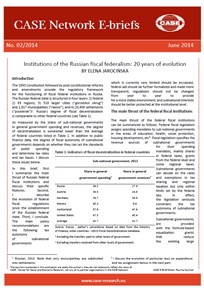Institutions of the Russian fiscal federalism: 20 years of evolution
 The degree of decentralization in Russia is somewhat lower than the average of federal countries such as Austria, Germany and the United States, at least when one measures it by the share of sub-national governments in general government spending and revenues.
The degree of decentralization in Russia is somewhat lower than the average of federal countries such as Austria, Germany and the United States, at least when one measures it by the share of sub-national governments in general government spending and revenues.
Given that in Russia revenues of the federal and subnational governments depend to a large extent on the price of oil, an important block of the federal fiscal legislation is the stabilization policy. The Reserve Fund, which was established in 2003, cushions the effect of the oil price fluctuations on the budget. In addition to the Reserve fund, Russia has a fiscal rule that ex ante caps federal government expenditures at a certain level which is determined by a five-year average of past oil prices. Fiscal legislation also establishes limits on deficits, debts and borrowing of sub-national governments.
Since 1993, the Russian federal fiscal legislation has been substantially improved and modernized. It provides for clear tax and revenue assignment, formula-based equalization grants, strict numerical rules and a modern budget process. However, a number of features still need to be improved.
The brief, authored by CASE Fellow, Elena Jarocinska, summarizes the main thrust of Russian federal fiscal institutions and discusses their specific features. The author describes the evolution of federal fiscal regulations since the establishment of the Russian federal state, and gives policy recommendations.

